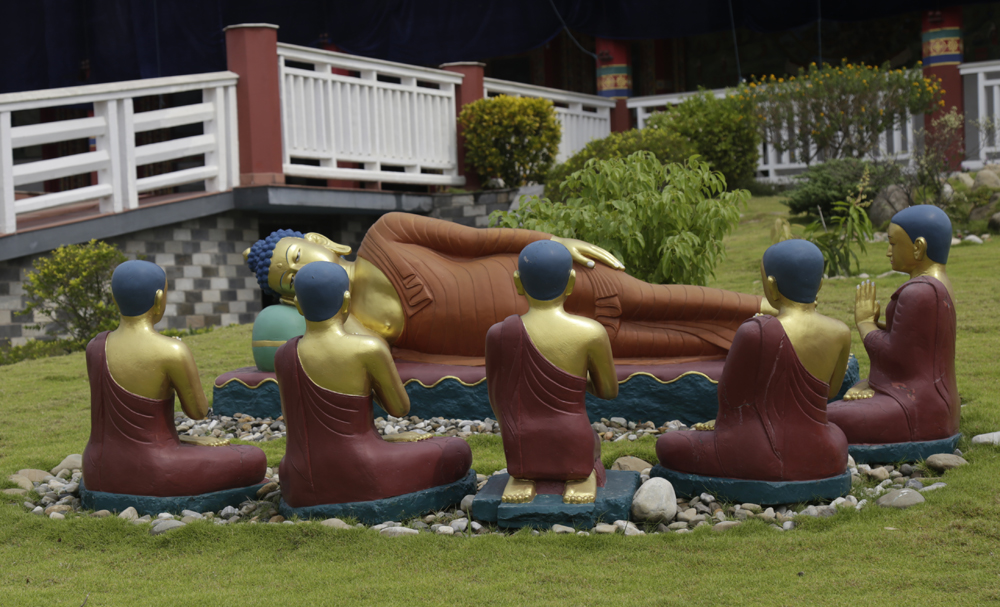
Nepal has a big market for Bollywood and any Bollywood celebrities coming to this small country is big news. The same happened earlier this week as star Amir Khan landed in Kathmandu, reportedly for a 10-day Vipassana meditation camp.
As Khan’s Nepali fans were happy about him coming to Kathmandu, the news left many of them wondering what this Vipassana is all about. So to quench your curiosity, here we explain the idea and its growing popularity in Nepal.
What is Vipassana?
Vipassana is a technique of meditation. It is claimed to be one of the oldest types of meditation and is often related to the teachings of Gautam Buddha. Although it is frequently taught in the context of Buddhism, meditation is not affiliated with any religious or spiritual tradition. It has grown in popularity across the world as a secular practice in which individuals of all backgrounds and faiths can participate.
Vipassana or ‘vi’ ‘passana’ means a special insight or clear sight in the ancient Pali language. In Vipassana meditation, practitioners typically focus their attention on their breath, bodily sensations, or other objects of awareness.
The goal is to cultivate mindfulness and develop a deep understanding of the impermanence, dissatisfaction and the nature of existence. So, it can be understood that the practice of Vipassana meditation aims to develop insight by observing something, with heightened awareness, especially in life or the present moment, without judgment or attachment.
Where can you do Vipassana in Nepal?

Anyone wanting to be enrolled in Vipassana and get the experience can reach out to:
- Dhamma Shringa Vipassana Meditation Centre, Budhanilkantha (Kathmandu). It has other branches across Nepal.
- Dhamma Kitti Vipassana Meditation Centre, Kirtipur (Kathmandu)
- Tushita-Nepal Meditation Centre, Pokhara (Kaski)
- Paṇḍitarama Lumbini International Vipassanā Meditation Centre, Lumbini (Rupandehi)
What do you do in Vipassana?
Vipassana meditation is often taught in retreat settings, where participants dedicate a period, ranging from a few days to several weeks, to intensive practice. These retreats typically involve periods of silent meditation, guided instructions and group discussions to support the participants’ progress.
The practice of Vipassana meditation typically involves:
- Preparing the mind: Before starting the formal practice of Vipassana, it is important to prepare the mind by creating a conducive environment and setting aside dedicated time for meditation. This may involve finding a quiet and comfortable space, minimising distractions, and committing to a regular practice schedule. But preparing the mind is also about convincing yourself and being sure that you can commit to going through the guided course without any difficulty.
- Developing concentration: Concentration is the ability to sustain attention to a chosen object without distraction. In Vipassana, practitioners develop concentration by focusing on a specific anchor, such as the breath, and training the mind to stay present with the chosen object. This helps them stabilise and calm the mind, preparing it for deeper insight.
- Observing sensations: One can shift their attention from the anchor (such as the breath) to a broader observation of bodily sensations. They systematically scan the body, observing any sensations that arise, whether pleasant, unpleasant or neutral. The goal is to observe these sensations with equanimity, without reacting or clinging to them.
- Establishing mindfulness: The foundation of Vipassana practice is mindfulness, which involves cultivating moment-to-moment awareness of one’s thoughts, feelings, bodily sensations and the surrounding environment. Practitioners begin by establishing mindfulness through focused attention on an object, such as the breath or sensations in the body.
- Cultivating equanimity: Equanimity is a state of non-reactive, balanced awareness. Meditation helps one cultivate equanimity by observing sensations without judgment or attachment. They learn to accept the impermanent nature of sensations and observe how they arise, persist, and eventually pass away. This process deepens the understanding of the transient nature of all experiences.
- Developing insight: Through the sustained practice of observing sensations with equanimity, practitioners develop insight into the true nature of reality. They begin to see the impermanence, unsatisfactoriness, and selflessness inherent in all phenomena. This insight leads to a shift in perception and a deeper understanding of the interconnectedness of all things.
- Integrating learning in daily life: The ultimate goal of Vipassana is not limited to meditation practice alone, but it is more about integrating the insights gained into everyday life. Practitioners, after Vipasanna, are urged to integrate the mindfulness and knowledge gained from formal meditation into their everyday activities, relationships, and interactions, resulting in increased clarity, compassion, and wisdom in all aspects of life.

What are the major benefits of Vipassana?
Though it is open and designed for all, the experience and benefits of meditation can vary from person to person and at different levels. But here are some expected results.
- Increased self-awareness: Vipassana helps develop a heightened sense of self-awareness by cultivating mindfulness. One becomes more attuned to their thoughts, emotions, bodily sensations, and patterns of behaviour, leading to a deeper understanding of themselves.
- Improved concentration: It enhances concentration and focus. By training the mind to stay present and anchored to the chosen object of meditation, practitioners develop the ability to retain attention for longer periods, both during meditation and in daily life.
- Stress reduction: As you improve your concentration and get relaxed, you reduce your stress too. People can establish a non-reactive and receptive attitude towards stressors by practising mindfulness and studying the nature of sensations and thoughts, resulting in lower levels of stress, anxiety, and related psychological and physical symptoms.
- Greater clarity: The Vipassana meditation technique is designed to develop insight into the true nature of reality. Through observing sensations and impermanence, practitioners gain a deeper understanding of the interconnectedness of all phenomena, leading to greater clarity, wisdom, and a shift in perspective.
- Improved relationships: By cultivating mindfulness, compassion, and understanding through Vipassana, individuals often experience improvements in their relationships. The increased self-awareness and ability to observe one’s reactions and behavioural patterns contribute to better communication, empathy, and harmonious interactions.
- Emotional resilience: One can train their emotional resilience by providing a space to observe and understand the transient nature of emotions. After meditation, one can learn to observe emotions without judgment or attachment, allowing them to respond to challenging situations with greater equanimity and emotional stability.
In other words, such transformative practice can lead to personal growth and positive behavioural changes. One may experience shifts in attitudes, values, and habits, leading to personal growth, increased well-being, and a more meaningful and purposeful life.
What types of courses are available?

Vipassana courses are available in a variety of lengths, formats and levels of intensity. Depending on the Vipassana organisation or tradition, the particular offers may differ.
Here are some examples of popular Vipassana courses:
- Introductory courses: These courses are usually shorter in duration, typically spanning over a weekend or a few days. They provide a basic introduction to Vipassana meditation and its principles. Introductory classes frequently include guided meditation sessions, mindfulness and insight teaching, and opportunities for group discussions. It can be for three days and up to 10 days.
- 10-day residential courses: A 10-day residential course is the most well-known course and traditional form of Vipassana training. It involves a rigorous and immersive experience in which participants live on-site throughout the course. These courses adhere to a strict schedule, generally beginning early in the morning and finishing late in the evening. Participants observe “noble silence” abstaining from any form of communication, and following a code of discipline that includes ethical guidelines.
- Long-term retreats: Some Vipassana centres offer longer retreats that extend beyond the 10-day format, even up to 60 days. They are designed for highly experienced meditators who want to enhance their practice and spend a significant amount of time in intensive meditation. They are intended for more experienced meditators who wish to deepen their practice and spend an extended period in intensive meditation.
- Non-residential courses: In addition to residential courses, some non-residential Vipassana courses are also available. These courses are designed for individuals who are unable to commit to living on-site for the entire duration. Non-residential courses may be structured as weekly sessions or weekend retreats, allowing participants to integrate meditation practice into their daily lives while still receiving guidance and support.
- Retreats for experienced meditators: Some Vipassana centres conduct customised retreats or courses for experienced meditators who have already completed a 10-day course or have an established meditation practice. These retreats often focus on deepening insight, exploring advanced meditation techniques, and providing a supportive environment for experienced practitioners to delve further into their practice.























